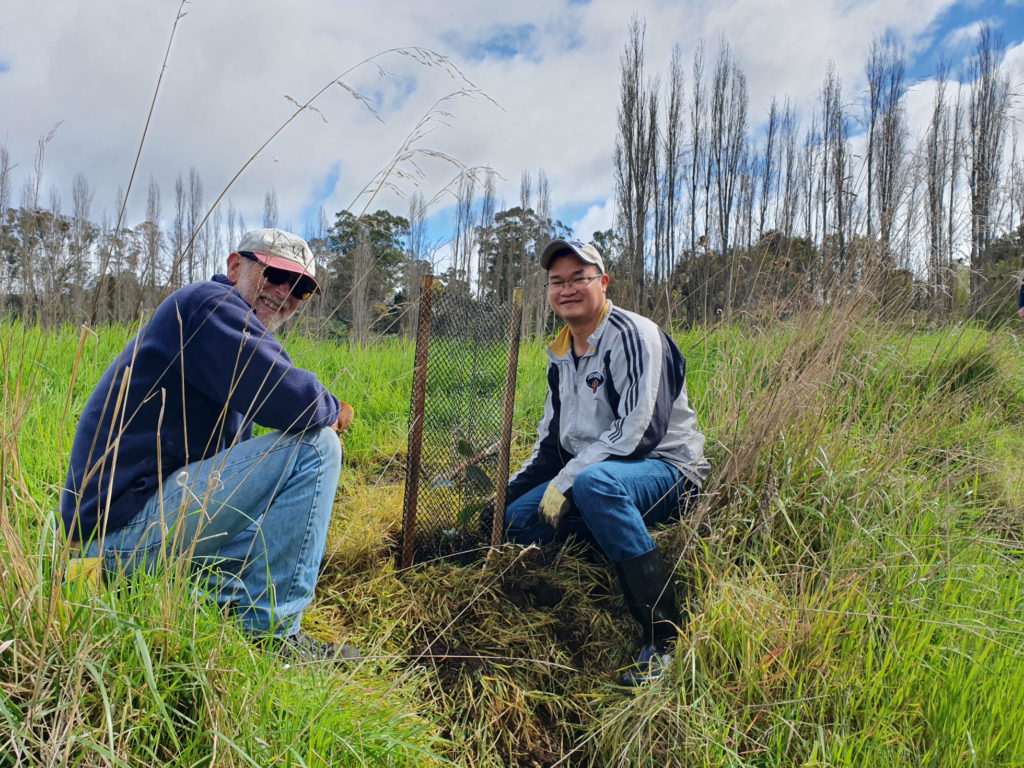Weeping Willows: How a Crack Team of Willow Warriors are Cleaning Up
by Stephanie Williams

Magali Wright leads a team of dedicated volunteers in saving the waterways of the Tyenna River and Derwent Estuary from an introduced species, the willow tree.
Why are willow trees a problem? Willows like water and grow in and along waterways. They are very good at outcompeting native trees. The main species we treat is crack willow as it’s very good at spreading along waterways – it grows from branches and sticks that are easily broken from trees. When these sticks and branches float downstream they get snagged and, within a small amount of time, new roots will grow and form a new willow tree. Like many introduced plant species, willows were brought to Australia as ornamental garden species in an attempt to make the landscape appear more like a northern hemisphere environment. It was also valued for wood to make cricket bats.
One of the most noticeable effects of willows in waterways is their root-mats. These mats grow out away from the riverbank, over rocks and begin to reduce the flow of water. If there are two trees growing either side of a river their root-mats will grow out and meet each other, this can reduce river flow, cause localised flooding and new river channels to form. Channelling can damage riverbanks and infrastructure such as roads and pumping stations. The localised flooding can also create damage to farmland and people’s homes. As willows are shallow rooted and have fragile branches, most of the debris after a flood in willow-infested rivers is willow branches and trunks.
Willow root mats also reduce habitat for native waterbugs, changing the diversity in the river and reducing food for fish and other aquatic species. Willows can also use more water than native vegetation, with one hectare of willow using 3.9-5 ML more than native vegetation in the same area. When willow leaves fall in the autumn they reduce water quality by reducing the oxygen in the water as they decay. Willows also restrict access to rivers for recreational activities such as angling and kayaking.
How do you get rid of a tree? It depends on its size and form. Some trees are rather large and require extra work whilst others can be simply pulled out by hand if they are small enough. Large trees are treated with a technique called Drill and Fill and/or Frill and Fill. This process involves drilling holes around the trunk with 50mm spacing and a water-safe herbicide applied directly to the holes. The holes expose the cambium layer of the tree, which is the area of the tree that transports water and nutrients. Through this layer the poison is taken directly into the living tissue of the tree. This process reduces the amount of herbicide needed and means there’s no off-target damage, and minimal risk to the waterway. Trees can be left to die standing in areas without important infrastructure such as bridges. Once the tree is dead it can be felled and removed from the riverbank. We like to kill the tree first as it reduces the chance of the tree creating more little willows through sticks and branches breaking off during the removal process.
If the tree is small, we can treat them with a similar technique called Cut and Paste. This simply means chopping the smaller diameter trunk off with snips and applying the same water-safe herbicide to the freshly cut area. It’s important with all techniques to apply the herbicide within 30 seconds, if you wait any longer the tree will seal-up the exposed area the same way we do with a cut to our skin.

What is your role in the program?
I have a background in plant conservation and horticulture research and teaching. Since moving to Tassie in 2010 I have worked on practical land management and threatened species programs and spent lots of time coordinating volunteer programs. I’m a Project Officer at the Derwent Catchment Project and coordinate the Tyenna River Recovery Program, the Derwent Catchment Biosecurity Working Group and undertake Strategic Planning activities – we recently worked with local agriculture and tourism business to develop a plan for sustainable growth of agriculture and tourism in the Catchment.
How can readers become a Willow Warrior? The best way to become a Willow Warrior is send me an email – magali@derwentcatchment.org. From there they will go onto our emailing list and be notified of upcoming events. Depending on the day it can be weed treatment, removal of dead willows from riverbanks, planting native species back into a treated area, maintenance of native plantings, water monitoring using the Waterbug Blitz or a combination of these activities in a single working bee depending on what is needed.
Are there other components of the Tyenna River Recovery Program? We’re working on a plan to eradicate crack willow from the Tyenna River over the next 10 years. We are removing willows with riverside landholders, local residents, the Inland Fisheries Service and Willow Warriors. In areas where dense willows are removed, we’re replanting native riverbank plants after willow control. We are also working with John Gooderham from the Waterbug Company to undertake yearly WaterBug Blitz along the river to help understand changes to water quality with the work we undertake. We’re working to fund a similar program with the Derwent Estuary Program looking at other measures of water quality such as nutrient levels and sedimentation. For more information about our plan, which is supported by the Fisheries Habitat Improvement Fund, can be found on our website at www.derwentcatchment.org.

